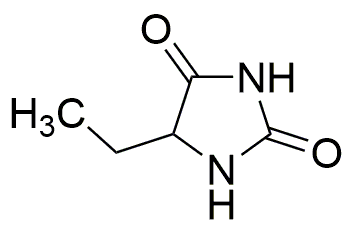5-Ethylhydantoin is widely utilized in research focused on:
- Pharmaceutical Development: It serves as a key intermediate in the synthesis of various pharmaceuticals, enhancing drug efficacy and stability.
- Cosmetic Formulations: The compound is incorporated into skincare products for its moisturizing properties, helping to improve skin hydration and texture.
- Agricultural Chemicals: It is used in the formulation of agrochemicals, acting as a stabilizer for pesticides and herbicides, which improves their effectiveness.
- Food Preservation: 5-Ethylhydantoin acts as a food preservative, extending shelf life by inhibiting microbial growth, making it valuable in the food industry.
- Polymer Chemistry: The compound is utilized in the production of specialty polymers, contributing to materials with enhanced durability and thermal stability.
General Information
Properties
Safety and Regulations
Applications
5-Ethylhydantoin is widely utilized in research focused on:
- Pharmaceutical Development: It serves as a key intermediate in the synthesis of various pharmaceuticals, enhancing drug efficacy and stability.
- Cosmetic Formulations: The compound is incorporated into skincare products for its moisturizing properties, helping to improve skin hydration and texture.
- Agricultural Chemicals: It is used in the formulation of agrochemicals, acting as a stabilizer for pesticides and herbicides, which improves their effectiveness.
- Food Preservation: 5-Ethylhydantoin acts as a food preservative, extending shelf life by inhibiting microbial growth, making it valuable in the food industry.
- Polymer Chemistry: The compound is utilized in the production of specialty polymers, contributing to materials with enhanced durability and thermal stability.
Documents
Safety Data Sheets (SDS)
The SDS provides comprehensive safety information on handling, storage, and disposal of the product.
Product Specification (PS)
The PS provides a comprehensive breakdown of the product’s properties, including chemical composition, physical state, purity, and storage requirements. It also details acceptable quality ranges and the product's intended applications.
Certificates of Analysis (COA)
Search for Certificates of Analysis (COA) by entering the products Lot Number. Lot and Batch Numbers can be found on a product’s label following the words ‘Lot’ or ‘Batch’.
*Catalog Number
*Lot Number
Certificates Of Origin (COO)
This COO confirms the country where the product was manufactured, and also details the materials and components used in it and whether it is derived from natural, synthetic, or other specific sources. This certificate may be required for customs, trade, and regulatory compliance.
*Catalog Number
*Lot Number
Safety Data Sheets (SDS)
The SDS provides comprehensive safety information on handling, storage, and disposal of the product.
DownloadProduct Specification (PS)
The PS provides a comprehensive breakdown of the product’s properties, including chemical composition, physical state, purity, and storage requirements. It also details acceptable quality ranges and the product's intended applications.
DownloadCertificates of Analysis (COA)
Search for Certificates of Analysis (COA) by entering the products Lot Number. Lot and Batch Numbers can be found on a product’s label following the words ‘Lot’ or ‘Batch’.
*Catalog Number
*Lot Number
Certificates Of Origin (COO)
This COO confirms the country where the product was manufactured, and also details the materials and components used in it and whether it is derived from natural, synthetic, or other specific sources. This certificate may be required for customs, trade, and regulatory compliance.


